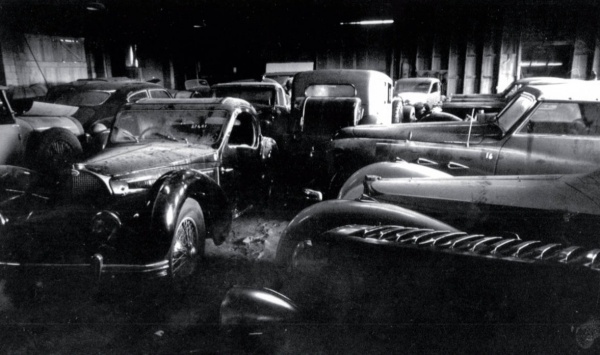
The 1964 Shakespeare-Schlumpf transaction is the grandest used-car deal in recorded history. After Volkswagen AG took over control of Bugatti in 1998, executives at the peoples’ car company thought it might be nice to own one of the six Type 41 Royales that Ettore Bugatti created as “the car for kings.” Purchasing a Royale Coupe de Ville cost VW an estimated $17 million, a shrewd investment given the estimated worth of Royales today. But contrast VW’s deal to one Fritz Schlumpf—in his day, the most ruthless carmonger on Earth—pulled off in 1964: $85,000 for one Park Ward Royale limousine and twenty-nine other Bugattis extracted from a dusty barn near St. Louis, freight to France included.
Fritz Schlumpf, who died in 1989, was a shady character. Born poor, he and his older brother Hans earned a fortune in the textile business. In the 1950s, the two owned four woolen mills, a villa, and most of the homes in the village of Malmerspach, France, in the Alsace region. Their family motto—Acquire, Possess, Dominate—didn’t mince words concerning their attitudes toward wealth and workers. During the German occupation in World War II, the Schlumpf factories supplied the wool for Wermacht uniforms.
Upon the passing of his mother in 1957, Fritz was moved to ponder her legacy as well as his own. He concluded that a monument to automobiles in general and to the cars that Ettore Bugatti constructed nearby would be an appropriate tribute to his mother and to the family’s region (his mother’s passion for cars is unknown; the son’s is legendary). A fifth mill was purchased in Mulhouse to serve as the repository for Schlumpf’s car collection. Mechanics, carpenters, and upholsterers were hired to refurbish the vehicles. By 1965, a staff of forty workers were on hand toiling over seventy Bugattis and 130 other cars Fritz had acquired.
Many of the Bugattis came Schlumpf’s way shortly after noted historian and marque enthusiast Hugh Conway compiled a worldwide registry listing every known Bugatti owner in 1962. That served as a convenient mailing list to Schlumpf, who dispatched a solicitation letter to every Bugatti owner listed.
John Shakespeare of Centralia, Illinois, received Schlumpf’s missive and mentioned to a fellow car enthusiast that he might consider selling his collection of thirty Bugattis for $105,000, the money he had invested in the lot. He also told a newspaper reporter, “It’s awful easy to get too many hobbies. Right now, I’m more interested in sports that I can actively participate in like waterskiing and sky diving.”
With near-Internet speed, Shakespeare’s conversation reached Conway, who quickly forwarded the scuttlebutt to Schlumpf. He responded with rabid enthusiasm. “Your communication surprised me as much as it gave me pleasure. Mr. Shakespeare’s collection interests me and we are going to try to make this deal,” Schlumpf noted.
The deal, according to Schlumpf, was worth $70,000 for thirty cars in impeccable condition, freight included.
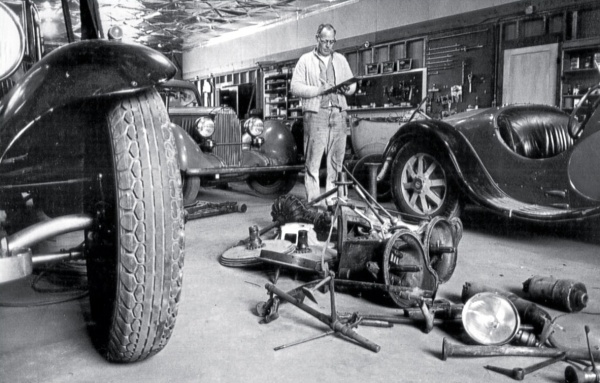
Shakespeare’s golden spoon upbringing was on the opposite side of the tracks from Schlumpf’s bootstrap roots. His father, William Shakespeare, invented two key fishing gear advancements: the level wind reel and the backlash brake. The company he formed at the end of the nineteenth century introduced both monofilament fishing line and fiberglass rods.
Following studies at Harvard graduate school, John settled in Centralia, Illinois, in 1950 to oversee various car dealership and oil business interests. His car enthusiasm began with a Porsche 356 and quickly escalated to Ferraris. He and Luigi Chinetti co-drove a Ferrari 375MM to a sixth-overall finish in the 1954 La Carrera Panamericana road race. A year later, when Briggs Cunningham closed his shop in Palm Beach, Florida, Shakespeare moved in with vague plans to produce his own low-volume sports car.
In 1956, while shopping for cars, Shakespeare discovered the Bugatti legend and promptly purchased a 1932 Type 55 supercharged sports roadster. Mere months later, a St. Louis newspaper headline proclaimed: “Centralia Man Buys Biggest, Costliest, and Rarest Car in the World.” In this instance, “costliest” was about $10,000 for a 1933 Bugatti Royale with limousine coachwork by Park Ward and Company of London. Shakespeare drove his prize home, noting that the mechanical brakes didn’t slow the 7,000-pound car very well on his 250-mile journey.
Schlumpf had no interest in dealing directly with the seller. Instead, he told Conway, “I’d like to inspect Shakespeare’s collection, but don’t have the time. Can you go in my place? If not, we’ll have to send someone in whom we have complete confidence. There are a lot of bandits in this field of car salesmen.” Conway delivered Schlumpf’s $70,000 contingency offer to Shakespeare and convinced Robert Shaw, the Bugatti Club member living closest to the collection, to conduct a thorough inspection of the goods. Shaw, the only survivor of this epic transaction, not only remembers many details, but also he preserved the correspondence and kindly shared it with me, shedding light on one of the shadiest used-car deals in history.
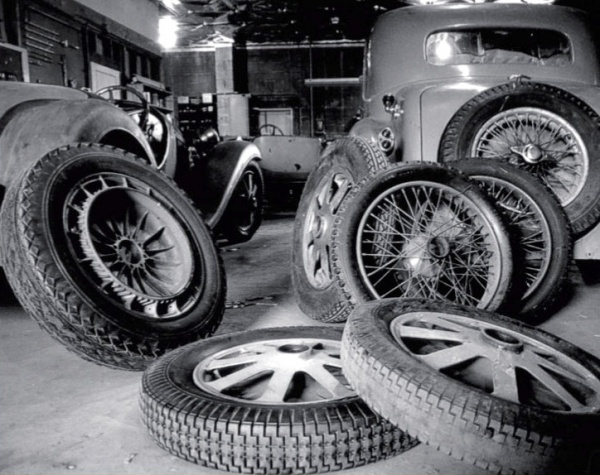
After acknowledging that five of his cars were disassembled for restoration, Shakespeare invited Shaw to inspect the collection, and he expressed willingness to let it go for less than his asking price— as long as the cars were destined for a suitable new home.
Shaw’s first report to home base was disparaging to say the least. “The Shakespeare collection is housed in a facility formerly used as a foundry. Most of the cars are in a dirt-floored building. The roof leaks, windows are broken, and birds are nesting inside. The better cars are in a heated, concrete-floored shop. Practically every car is in some state of disassembly; none has run in eighteen months,” he noted.
“The Royale, the Type 56 electric inspection vehicle, the Type 55 roadster, and the Type 13 three-place light car are in presentable condition. It appears that Mr. Shakespeare was taken advantage of when he purchased others sight unseen. The Type 50 LeMans is a replica of some sort. Another car is made of Buick parts.”
Shaw’s recommendation to Schlumpf: Do not buy the collection.
That suggestion was ignored. Conway wrote Shakespeare: “Mr. Schlumpf is keen and has the workmen to put these cars back in order. He has offered to stand by his price subject to the Royale being roadworthy.”
A month later, Schlumpf raised his bid to $85,000. While prepping the cars for shipment, Shakespeare made this disheartening discovery: the Royale’s engine block was cracked. Schlumpf’s response was to have a mechanic repair the 238-pound lump with arc welding.
Shakespeare was so disgusted by that suggestion and the deal in general that he washed his hands of the sale and left for Florida on vacation.
Shaw, skeptical the transaction would ever take place, was dispatched to save the day. He found that the southern respite had brightened Shakespeare’s mood. Annoyed when he learned that Schlumpf already owned several Bugattis, Shakespeare nonetheless resumed assembling pieces—two of his cars were in Florida—and preparing (probably bogus) invoices according to Schlumpf’s instructions.
Unfortunately, Shakespeare’s efforts were too deliberate for Schlumpf. After his request for a shipping date was ignored, Schlumpf pressed, “I wrote you nicely and prettily without animosity. But you must not confound or translate my prettiness with weakness.” The French industrialist threatened to lodge formal complaints through ten institutions ranging from “the American tribunal and court of justice” to “all Bugatti clubs and automobile reviews [magazines] in the world.” He set a deadline of four months for shipment and threatened to claim damages of $500 per day if Shakespeare didn’t comply.
Shakespeare responded with two months of silence, followed by the hint that his collection might be broken up “to perpetuate the great Bugatti tradition.” Soon thereafter, Schlumpf characterized a letter he received from Shakespeare’s attorney as blackmail. From the sidelines, Shaw silently cheered Shakespeare for not caving in.
Late in 1963, the quixotic Shakespeare resumed a friendly dialogue as if no harsh words had ever been traded. His progress report to Schlumpf advised that the Florida cars had been moved to Illinois, but he was having difficulty finding new tires for the Royale. Unfortunately, no space was available for shipping the cars until the following spring.
In February 1964, after fourteen months of dickering, Shakespeare told Schlumpf, “Your cars are ready. I am eager to have this transaction completed and when I get the money, I will ship the cars.”
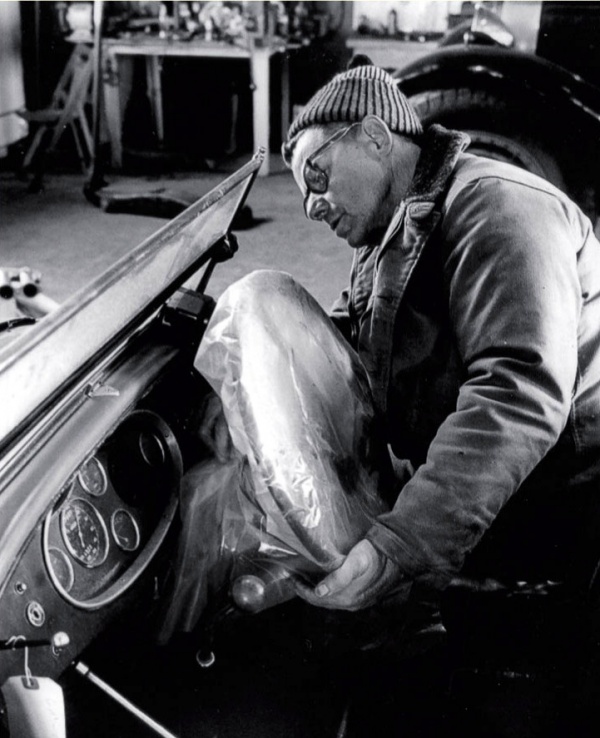
Shortly thereafter, three Southern Railway freight cars were backed onto a siding that ran within yards of Shakespeare’s storage building. While a mechanic steered, railway workers heaved Ettore Bugatti’s personal inspection runabout to a top berth. The car made its final journey on U.S. soil at the end of a chain towed by a Jeep.
David Gulick, then a staff photographer for the St. Louis Post-Dispatch’s Sunday Pictures magazine, was present to document the loading process. He coaxed a smile from Shakespeare as the eccentric collector removed the Royale’s Brogue chronometer and prancing elephant radiator mascot for separate packing. All the cars were shipped with no protection from damage beyond steering wheel wrappers. At the end of a long loading day, the thirty Bugattis left Illinois en route to New Orleans. There they were transferred to a Dutch freighter bound for Havre, France.
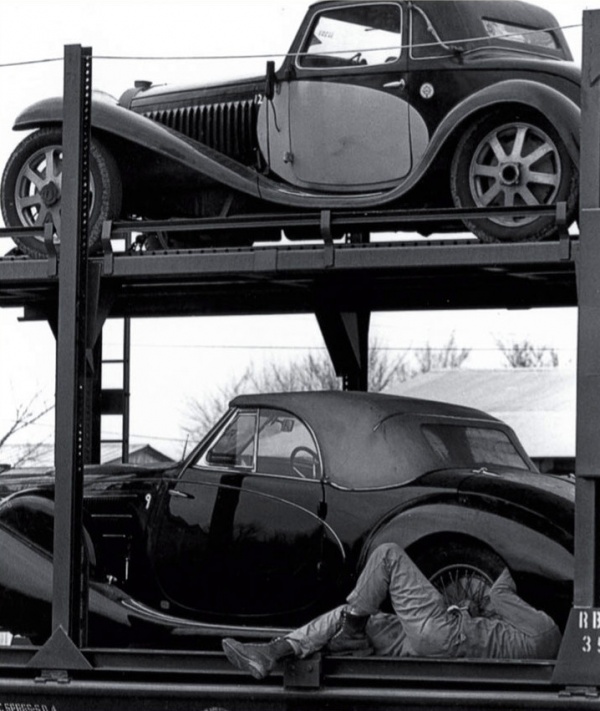
Upon arrival in Mulhouse, “His Highness” Fritz Schlumpf stood armed with a whip to shoo away the curious. There were plenty of onlookers, including journalists who had been pestering the despot for access to his horde after hearing about the Shakespeare cars and fourteen other significant Bugattis he had purchased from Hispano-Suiza.
Two years before, Schlumpf initially denied Conway’s wife Eva admission to his collection. When Automobile Quarterly editor L. Scott Bailey repeatedly asked for a visit, Schlumpf told him that he was contemplating a press event of epic proportions; on the condition that no journalist ever request a return visit, each car would be wheeled into the sunlight for fifteen minutes.
Schlumpf treated his employees with equal disdain. Their grievances about working conditions and the diversion of company resources were ignored. In 1972, the rise of socialism prompted bitter strikes. Locked out of their mills and barricaded from their villa, the Schlumpf brothers seized refuge in the mill that had been lavishly refurbished as a car museum. While business conditions deteriorated with rampant inflation, worker unrest, and rising competition from synthetics, the Schlumpfs poured their wealth and energy into their car collection.
By 1976, the museum was ready for its public opening. Since the mills were writhing in debt, the brothers magnanimously offered to sell all their holdings—except the museum—for one franc. That prompted embezzlement charges and threats of bodily harm. The brothers fled to Switzerland and the workers seized control of both the factories and the museum.
Imagine their amazement when the Schlumpf shrine—three football fields in size—was raided in 1977. There were 122 Bugattis and 305 other pristine automobiles parked on carefully laid beds of white gravel. Another 150 cars in storage awaited restoration. Ornate Venice Grand Canal candelabras sparkled from eight hundred roof pillars. Three restaurants stood ready to host twelve hundred diners. The washrooms were lavishly decorated with giltedged mirrors.
Tried in absentia for tax evasion, falsified accounting, abuse of assets, and gross mismanagement, Fritz Schlumpf was sentenced to a four-year prison term and fined $10,000. His brother received the same fine with a two-year term. Neither served a minute behind bars.
The museum was liquidated by the courts to pay the Schlumpf’s debts. The new owners christened the facility Muse National De L’Automobile in 1982. After the Louvre and the Eiffel Tower, it’s one of France’s most popular tourist attractions. Most of the collection is still on display today, including some of the Shakespeare cars. But you won’t find the Royale’s elephant mascot or its chronometer. Suspicions are that the Schlumpfs carried that booty to exile.
This story does not end happily for the protagonists. In 1975, Shakespeare was found dead in the basement of his home. The sixty-nine-year-old bachelor had been handcuffed, gagged, and shot once in the head. Police interrogated suspects in ten states and at least three foreign countries but no charges were filed and no arrests were made.
Hans Schlumpf died in 1989. Fritz was allowed only a brief visit to his collection before his death in 1992.
Those who visit the Schlumpfs’ museum should keep an eye peeled for one very special car on display. The Type 38 two-place roadster, lovingly “rebodied by Shaw of America,” was donated to the collection by the Robert Shaw who preserved this Bugattis-in the-barn story.
By Don Sherman, Technical Editor, Automobile Magazine.
This story originally appeared in Tom Cotter’s The Hemi in the Barn.
Subscribe to our email list for a chance to win a free copy and be sure to submit your own stories because one is going to make it into Tom’s next book!



Thanks for that terrific tale. Given the era in which many of the brothers’ cars were acquired, as well as their reputation and their apparently close relationship with the German government, I would not be surprised if some of the other cars were of questionable provenance.
~ a fascinating story. suspense, intrigue, and begs for a sequel!
I remember seeing a story about the purchase of the Shakespeare Bugatti collection in a car magazine back in the 1960s. There were a number of dreary B&W photos of workers loading the Bugattis on open freight train cars for shipment overseas, with Mr Shakespeare standing by watching the process looking rather glum. As I recall, the Schlumpfs weren’t mentioned and the whole deal sounded pretty mysterious.
Years later the British car magazines began to talk about the biggest collection of Bugattis in the world being owned by the Schlumpf Brothers and being on display in Mulhouse, France in a former woolen factory. Then the problems of the Schlumpfs began to come out, the French Government took over, and the outcome for all those Buggatis began to look pretty uncertain. As this soap opera developed it began to look like the collection would survive and become an important feature of car culture in France, which I guess it has. As I recall, the Royales became some of the first vintage cars to sell for multi-million dollar amounts, and not playing in that league, I lost interest in the saga.
I don’t think any of us who read about the the Shakespeare Bugatti sale back in the 1960s had any idea how strange it was or how bad things would end up for Shakespeare and the Schlumpfs, but reading about the Shakespeare Bugatti deal in Tom’s Hemi In The Barn book brought it all back and put it all in perspective. Thanks for another great read, Tom.
another great story. it does seem strange and somewhat sad.
Around 1988 while visiting a buddy, he shared this story with me and then pulled out a coffee table book called “The magnificent obsession “. Several years later, while living in Europe, I found myself in mulouse france on a rainy Sunday . Of my five years living in eu, that museum trip remains a highlight.
That’s a good story, a tale worthy of a movie. It’s got all the intrigue and mystery of a modern crime/spy movie. And it’s true as well. Great post!
In the late 1950s, I was a boy living in Danville, Il. Mr. Shakesspeare owned a Porsche franchise in that city and had a dealership out on Vermillion AV. Among the cars in his shop was a HUGE Bugatti Royale. As a boy, of course, I had no idea what it was. It was just an old and huge car among the Porsches. As I remember, its fenders were castings rather than being sheet metal. The car was of no interest. I sat on it to watch a motor being removed from a Porsche. I would give anything to go back to that shop for another afternoon. Porsches and Bugattis sitting around for young boys to look at. Wow.
I remember visiting this museum in 1987 while stationned in Germany with the USAF. I made the mistake of going to Mulshiem (where I guess Bugattis were made) instead of Mulouse. After realizing the error, I had to re-group and head South to Mulouse. I was amazed at the size of the collection, and the variety of automobile manufacturers exhibited. I had the whole place to myself back then, I took alot of photos. Great trip, good times. Someday I’d like to get back there with my father and my son.
One tiny comment on a fascinating jpg of a grand story. Halwart Schrader described the lamp posts as recreations of those on the Alexander III bridge in Paris. I had read elsewhere that they were all new castings. The Schlumpfs purchased the original set when they were replaced on the bridge, then had a foundry recreate the form. One of the originals is also on display in the museum. Jus sayin’
The lights in the Musee National des Automobiles, ex-Schlumpf Collection, are NOT copies of the lights in Piazza San Marco in Venice. I don’t know how this absurd notion ever got started, especially since they look nothing at all like the Venetian lights. They are copies of the lights on the Pont Alexandre III in Paris. Mr Cotter got this from somewhere and never bothered to check it out himself. The Schlumpfs bought the lights from the City of Paris when they were being replaced with copies. There were not nearly as many as the Schulmpfs needed for their huge exhibition space in Mulhouse, so they had exact copies made by a local foundry, restored one of the originals and displayed it with the others. Anyone interested in this can find plenty of pictures of the Pont Alexandre III and the Piazza San Marco online and see for themselves.
In addition to bewildering description of the lamps, this article contains a gross mis-representation of Conway’s involvement in the transaction. He did not ‘quickly forward the scuttlebutt to Schlumpf.’ In fact completely the opposite he began working with a group of Bugatti owners and enthusiasts to put together a counter offer which would have kept the cars in public use. Conway and many others in the Bugatti world at that time were well aware of what the Schlumpf brothers were up to.
Having just spent 4 and a half glorious hours last Thursday at the Musee National des Automobiles nothing could match the majesty of this collection. Certainly all cars are not to perfection but are in good to near perfect condition including the fabulous Ferrari 1964 Type 250 LM having under 2000 miles on the clock on loan from the original Swedish owner.
The most recent addition is a fully restored, about 2000 hours, Alpine-Renault A110 donated by the only woman club member of ABAHR (Amateurs de la Berlinette Alpine du Haut-Rhin), Colette Schroeder. The car entered the Museum workshops in December of 2008 and a group of the club members started work in January of the following year. The chassis was separated from the body and repaired Retro Sports, the interior of the car was done by Les Selliers du Domaine and the major mechanical work by specialists and other club members. This car is placed near the exit across from the splendid recreation of the Esders Royale along with the wooden forms over which the body was recreated.
For those unable to make it to see this treasure there is currently an Applestore App under the name culturespaces. There are 6 choices in the category and all are worth getting for free but the one to choose here is Cite de l’Automoblie (in English).
For those wishing to see more pictures and ultimately a few video walk through segments of the contents of the museum I have started publishing them on Instagram under the ID redlinecarsdotcom.10 photos currently listed and more to be posted every day until I run out.
I also was just at the museum a couple of weeks ago. It is truly mind-blowing. It’s actually too much in one place…. I walked by a 540K before I realized it and had to go back… definitely recommended place to visit. The parking lot is also fun… :) -lj
I live in centralia, illinois , I have been involved in research and the investigation of John W Shakespeare unsolved murder and cover-up / conspiracy. A lot of people in this town still will not talk about. People have tried to get unsolved mystery’s and cold justice shows to come ,and the police have turned them all away. You might ask why ? Give you some reasons why, Evidence the weapon a .22 caliber handgun .In 1976 police chief Franklin at the time said the gun was found 2 days later. In 1980 the chief of police Justice at that time said the gun was not located .And in 1995 police chief Speidel at that time said he believes the gun was in the police dept’s basement and was sold as police surplus inventory. But retired police chief Franklin said Last time he saw it ,it was in the basement. And then he said the guns current status really doesn’t matter? Really now ! I have a total inventory of all of John’s Bugatti’s . I have the colors ,motor, chassis, length complete and removed ,width, height, track front and rear, wheel bore axle to axle.
Great job on the John W. Shakespeare Bugatti Cars . Their is a great video and story on U -Tube on Shakespeare’s Bugatti Cars to. Called : The Bugatti List
I went to Muelhouse, when I heard the help were burning the cars out in front. They over took the bldg. because the brother’s were spending their money on car’s in-
stead of repair of the bldg. and payroll. When I arrived at the front of the bldg. sure enough their was a fire. I asked if I could go inside, had to pay them first, don’t know how much because it was in French money. I spent hours inside taking pict-ures.The brother’s escaped taking with them the hood ornament of the elephant off the Bagatti Royal. The reason for my going was to put together an auction. They agreed, but said if the auto got to the border if the guard said it was a car it could leave the country, if he said it was a piece of art it could not leave. So I returned to the United States with only pictures. Thanks Dr. Kemper
I grew up surrounded by six Bugattis owned by my Father in the 60’s until a few years ago.
My Mother still has a letter written by Hugh Conway on behalf of Fritz Schlumpf trying to get my Father to sell his Bugattis. My Father refused outright saying that the cars were worth much more to him than any amount of money.
Rudy van Daalen Wetters
Do you have any photos Rudy? We would love to see them!